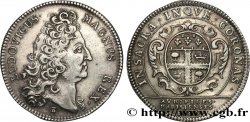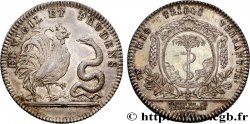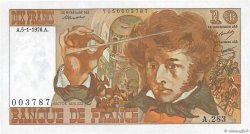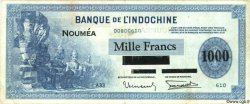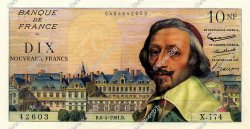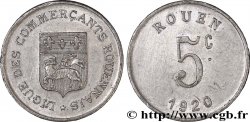Live auction - fjt_587812 - CORPORATIONS - LES SIX CORPS DES MARCHANDS DE PARIS CINQUIEME CORPS DES MARCHANDS LES BONNETIERS 1758
Devi Sign-in ed essere un offerente approvato fare un'offerta, Login per fare offerte. Conti sono soggetti ad approvazione e di approvazione sono raggiunti entro 48 ore. Non aspettare fino al giorno di una vendita si chiude per registrarti.Confermando la tua offerta su questo oggetto ti impegni ad un contratto legalmente vincolante per l'acquisto di questo prodotto e fare clic su «offerta» costituisce accettazione dei termini di utilizzo de live auctions cgb.fr.
Offerta deve essere collocato in euro gli importi interi vendita only.The si chiuderà al momento sulla descrizione dell'oggetto, eventuali offerte pervenute al sito dopo l'orario di chiusura non verranno eseguite. Volte transmition possono variare e le offerte potrebbero essere respinto se si attende per gli ultimi secondi. Per ulteriori informazioni ckeck le FAQ Live auction.
Le offerte vincenti saranno sottomesse ai 18% per spese di compartecipazione alla vendita.
Le offerte vincenti saranno sottomesse ai 18% per spese di compartecipazione alla vendita.
| Valutazione : | 100 € |
| Prezzo : | no offerta |
| Offerta maxima : | no offerta |
| Data di fine vendita : | 28 luglio 2020 18:40:27 |
Tipo : CINQUIEME CORPS DES MARCHANDS
LES BONNETIERS
Data: 1758
Metallo : rame
Diametro : 28 mm
Asse di coniazione : 6 h.
Peso : 6,80 g.
Orlo : Lisse
Grado di rarità : R2
N° nelle opere di riferimento :
Diritto
Titolatura diritto : LUD. XV. REX. CHRISTIANISS.
Descrittivo diritto : Buste à droite de Louis XV signé fm.
Traduzione diritto : Louis XV, roi très chrétien.
Rovescio
Titolatura rovescio : QUANTOS. DUO. FLECTIT. IN. USUS ; À L'EXERGUE : LES. MDS. BONNETIERS. 1746.
Descrittivo rovescio : Écu aux armes des Bonnetiers : cinq navires allant à gauche sous une étoile et au-dessous de la Toison d'or couronnée.
Traduzione rovescio : Vers combien d'usages il les tourne tous les deux !.
Commento
En 1390, on comprend sous le titre de bonnetiers, les aumussiers, les mitainiers et les chapeliers. Dans les premiers temps de la fabrication appelée plus tard bonneterie, on appelait bonnet le fil de laine tissé à la main avec l'aiguille et la broche. Les bonnetiers ont le droit de vendre toutes sortes de bonnets de drap, de laine, ronds ou carrés, des bas, gants, chaussons, camisoles, caleçons, au métier, au tricot ou à l'aiguille, en soie, laine, coton, chanvre ou lin, poil de chameau ou de castor et autres pareilles matières.
Les bonnetiers étaient chargés de tisser à la main le fil de laine avec une aiguille, la bonneterie, ou à l’aide d’une broche, pour le broché ou “jersey”. On les appelait aussi chapeliers, gantiers ou mitainiers mais avec le temps le terme bonnetier devient générique. Leurs statuts sont rédigés en 1550 et confirmés en 1608. En 1660, un arrêt décide qu’ils auront préséance sur les orfèvres et seront désormais au cinquième rang des marchands, ce que rappelle les cinq navires sur leur blason ou au revers de ce jeton. En 1776, unis aux chapeliers et pelletiers ils formeront le troisième des six corps. Au XVIIIe siècle il y a environ 450 maisons de bonneterie à Paris. La devise du revers est strictement liée à la corporation des bonnetiers (F. 4872-4880b).
In 1390, the title of hosier included the almussiers, the mitteners and the hatters.. In the early days of the manufacture later called hosiery, the woolen thread woven by hand with a needle and spindle was called a bonnet.. Hosiery makers have the right to sell all kinds of cloth or woolen caps, round or square, stockings, gloves, slippers, camisoles, underpants, loomed, knitted or needle-knitted, in silk, wool, cotton, hemp or linen, camel or beaver hair and other similar materials..
Hosiery makers were responsible for weaving wool yarn by hand with a needle, hosiery, or using a spindle, for brocade or “jersey”. They were also called hatters, glovers or mitteners but over time the term hosier became generic.. Their statutes were drawn up in 1550 and confirmed in 1608. In 1660, a decree decided that they would have precedence over the goldsmiths and would henceforth be in the fifth rank of merchants, as recalled by the five ships on their coat of arms or on the reverse of this token.. In 1776, united with the hatters and furriers, they formed the third of the six corps. In the 18th century there were around 450 hosiery houses in Paris.. The motto on the reverse is strictly linked to the hosiery guild (F. 4872-4880b)
Les bonnetiers étaient chargés de tisser à la main le fil de laine avec une aiguille, la bonneterie, ou à l’aide d’une broche, pour le broché ou “jersey”. On les appelait aussi chapeliers, gantiers ou mitainiers mais avec le temps le terme bonnetier devient générique. Leurs statuts sont rédigés en 1550 et confirmés en 1608. En 1660, un arrêt décide qu’ils auront préséance sur les orfèvres et seront désormais au cinquième rang des marchands, ce que rappelle les cinq navires sur leur blason ou au revers de ce jeton. En 1776, unis aux chapeliers et pelletiers ils formeront le troisième des six corps. Au XVIIIe siècle il y a environ 450 maisons de bonneterie à Paris. La devise du revers est strictement liée à la corporation des bonnetiers (F. 4872-4880b).
In 1390, the title of hosier included the almussiers, the mitteners and the hatters.. In the early days of the manufacture later called hosiery, the woolen thread woven by hand with a needle and spindle was called a bonnet.. Hosiery makers have the right to sell all kinds of cloth or woolen caps, round or square, stockings, gloves, slippers, camisoles, underpants, loomed, knitted or needle-knitted, in silk, wool, cotton, hemp or linen, camel or beaver hair and other similar materials..
Hosiery makers were responsible for weaving wool yarn by hand with a needle, hosiery, or using a spindle, for brocade or “jersey”. They were also called hatters, glovers or mitteners but over time the term hosier became generic.. Their statutes were drawn up in 1550 and confirmed in 1608. In 1660, a decree decided that they would have precedence over the goldsmiths and would henceforth be in the fifth rank of merchants, as recalled by the five ships on their coat of arms or on the reverse of this token.. In 1776, united with the hatters and furriers, they formed the third of the six corps. In the 18th century there were around 450 hosiery houses in Paris.. The motto on the reverse is strictly linked to the hosiery guild (F. 4872-4880b)







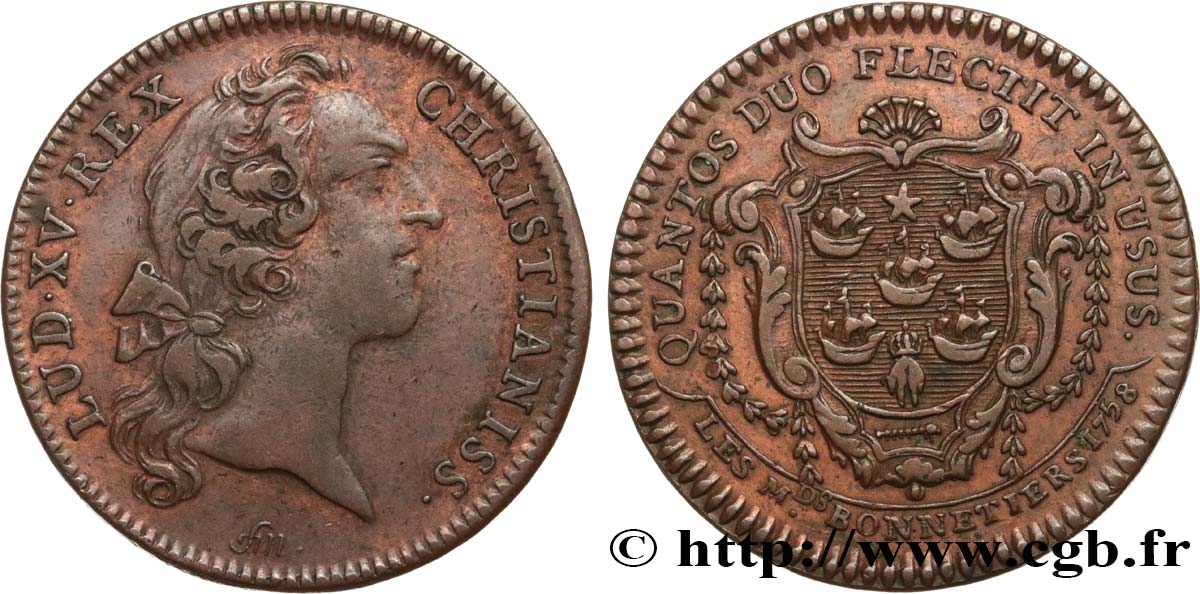
 Segnalare un errore
Segnalare un errore Stampate la pagina
Stampate la pagina Condividi mia selezione
Condividi mia selezione Fai una domanda
Fai una domanda Consegnare / vendere
Consegnare / vendere
 Descrittivo
Descrittivo